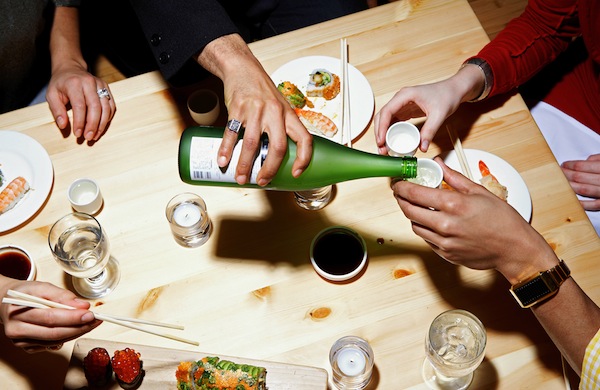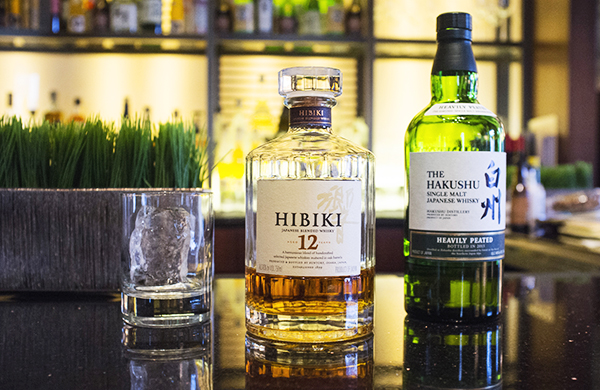
Japan’s most famous alcoholic beverage might seem tough. Confusion over sake alcohol content reigns. It’s easy to imagine a “sake bomb” leaving your
sushi dinner a pile of smoking rubble—and diners in even worse shape. But like a rugged samurai who writes love poems on his nights off, sake has a gentle heart.
This gentleness, or approachability, is something sake experts wish more Americans could understand. One such expert is John Gauntner, the only non-Japanese person to become certified both as a sake expert assessor and a master of sake tasting. The author of several well-respected books on sake, Gauntner has made a career out of teaching others about sake’s nuances, which he said often go unappreciated because of sake’s reputation as a strong liquor.
“A lot of people think it’s a distilled
spirit, or that it’s harsh,” he told me on a slightly crackly Skype call from Tokyo, where he spends part of the year. “But it’s only 16% alcohol, which is only 3% more than a robust red wine.”

As president of the the
Sake Education Council, Gauntner shares this and other knowledge in the sake certification seminars he teaches for industry professionals four to five times a year. (He also recently launched a quarterly magazine,
Sake Today.) But you don’t need intense study to start pairing sips with your next sushi boat.
Below are a few tips that Gauntner says will help even the greenest newbie “immediately enjoy their sake experience.”
Pick a bottle based on budget.
“One of the wonderful things about sake is there aren’t really scores or things that affect sales. Basically, the more you pay, the better the sake is going to be. Now, certainly personal preferences come into play. For example, if there was a really expensive sweet sake, but you like dry sake better, you’re better off going with a less expensive dry sake. But if you don’t know very much about what’s in front of you, make a decision on price, based on budget. About 90% of the time, sake is going to be fairly priced.”
Look for the magic word: ginjo.
“If you drink sake with the word
ginjo somewhere on the label, you’re drinking the top 10% of all sake. Drink
ginjo and you’re sure to be drinking good stuff. The term legally means that the rice had to have been milled to a particular degree before you brewed the sake. What that does is it removes fat and protein and leads to a cleaner fermentation and a lighter, more elegant, more refined sake.”
Chill it to bring out flavor.
“The way they brew
ginjo, it has a lot of aromas and flavors that are best brought out when the drink is slightly chilled. Warming that will bludgeon out of existence what those brewers worked so hard to create. So almost all the time, you’re going to want to drink your
ginjo slightly chilled.”
Pair it with just about any food …
“Fish is definitely a shoo-in, as are vegetable dishes. [But] to me, sake is so food-friendly that it’s difficult to say anything doesn’t go with it. Sake’s got no tannins and rarely does it have excessive acidity. And excessive tannins and excessive acidity are two of the problems you have with wine. … Even lightly grilled meats, if the sauces aren’t too intense, go well with some styles of sake. There’s a particular type of production method called
yamahai that leads to a particularly gamy sake, and that’s always a wonderful pairing for meat dishes.”
… except maybe barbecue.
“Sake really rarely clashes with anything, but it can be overpowered by something. You want to avoid stronger dishes, like really spicy things like Indian or Thai food. A big, sloppy barbecue [dish] probably would not go well with sake either. But once you remove those obvious mismatches, you’ve got a wide range of things.”
Pay attention to subtle flavors.
“Sake has much more [diversity] than most people conceive of. But it’s like all things Japanese. If you look at sashimi it’s like, come on, it’s raw fish. But no, each one has subtly different flavors, the way you cut it makes a difference. There aren’t huge, bold, two-by-four-upside-the-head flavors with
Japanese food. But if you take the time to discern them, they’re very, very different. They’re very, very interesting. And sake’s probably along those same lines.”
View our guides to other elements of Japanese cuisine:
 |
 |
| Japanese Whisky: A Beginner’s Guide |
Sushi: A Beginner’s Video Guide |
Shop Goods for kitchen and dining accessories:






 Japan’s most famous alcoholic beverage might seem tough. Confusion over sake alcohol content reigns. It’s easy to imagine a “sake bomb” leaving your
Japan’s most famous alcoholic beverage might seem tough. Confusion over sake alcohol content reigns. It’s easy to imagine a “sake bomb” leaving your 



